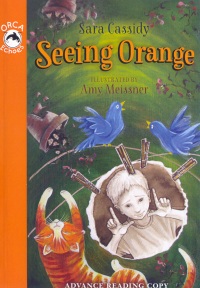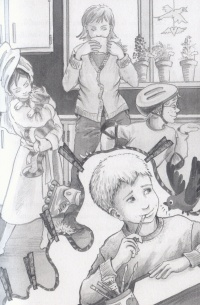| ________________
CM . . . . Volume XIX Number 5 . . . . October 5, 2012
Seeing Orange is the story of Leland, a boy in second grade who struggles at school. Instead of being supportive, his teacher seems strict and demanding. When Leland is asked to write, he stares endlessly at the blank page and then has to stay in for recess. Mr. Carling's punishments only make Leland more frustrated and withdrawn until Leland comes up with a few survival techniques. The first is an imaginary dog named Delilah. Like a seeing eye dog, Delilah guides him into class each day and provides comfort. His second coping mechanism is drawing. Leland is a talented artist and is able to draw in much greater detail than he can write.
Throughout the 10 chapters, readers will find several full-page drawings of Leland dealing with his many challenges. Meissner's illustrations of Leland, Mr. Carling and the other minor characters are helpful to readers because they clearly show what Leland is feeling. Intended for the school market, this Orca reader offers a story that will appeal to boys as well as girls in the primary grades. Themes of loneliness, friendship, and perseverance are ones to which many students will relate. The vocabulary is manageable but still interesting, and Cassidy does a thorough job of describing her characters and settings. The ending is satisfying and uplifting, leaving readers with a good feeling about appreciating our abilities and facing challenges. Recommended. Claire Perrin is an elementary teacher with the Toronto District School Board.
To comment
on this title or this review, send mail to cm@umanitoba.ca.
Copyright © the Manitoba Library Association. Reproduction for personal
use is permitted only if this copyright notice is maintained. Any
other reproduction is prohibited without permission.
NEXT REVIEW |
TABLE OF CONTENTS FOR THIS ISSUE
- October 5, 2012.
AUTHORS |
TITLES |
MEDIA REVIEWS |
PROFILES |
BACK ISSUES |
SEARCH |
CMARCHIVE |
HOME |

 There are several storylines in Seeing Orange which makes it a little difficult to distinguish which one is the main one. The title suggests that the book is about the loss of Leland's orange tabby cat named Pumpkin. However, in reading the book, it seems that Leland's struggles at school are the main problem. Yet another storyline is about Leland developing as an artist. He paints a picture for a neighbour who turns out to be an artist herself and who offers to help Leland with his painting. This mentoring gives Leland some much needed confidence at school. Towards the end of the book, Leland courageously tells Mr. Carling that staying in at recess only makes him mad and resentful. They agree that, as long as Leland is trying hard, he won't be asked to stay in. Once Leland has stood up to his teacher, his imaginary friend Delilah is no longer needed. Finally, during one of his art lessons with his neighbour, Leland is observing all the details in the neighbour's backyard when he suddenly notices his cat hiding in the garage. Although all the storylines are interconnected in a satisfying way, young readers may not be accustomed to having three subplots going on in one book.
There are several storylines in Seeing Orange which makes it a little difficult to distinguish which one is the main one. The title suggests that the book is about the loss of Leland's orange tabby cat named Pumpkin. However, in reading the book, it seems that Leland's struggles at school are the main problem. Yet another storyline is about Leland developing as an artist. He paints a picture for a neighbour who turns out to be an artist herself and who offers to help Leland with his painting. This mentoring gives Leland some much needed confidence at school. Towards the end of the book, Leland courageously tells Mr. Carling that staying in at recess only makes him mad and resentful. They agree that, as long as Leland is trying hard, he won't be asked to stay in. Once Leland has stood up to his teacher, his imaginary friend Delilah is no longer needed. Finally, during one of his art lessons with his neighbour, Leland is observing all the details in the neighbour's backyard when he suddenly notices his cat hiding in the garage. Although all the storylines are interconnected in a satisfying way, young readers may not be accustomed to having three subplots going on in one book.